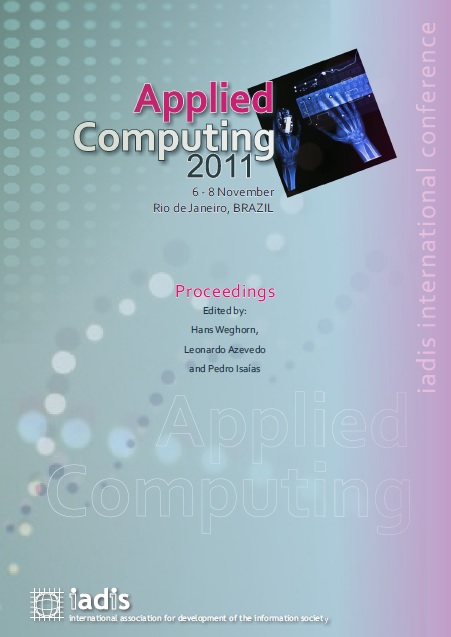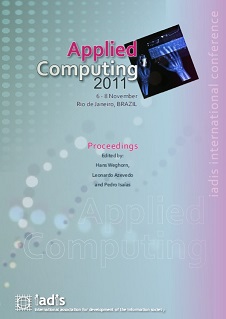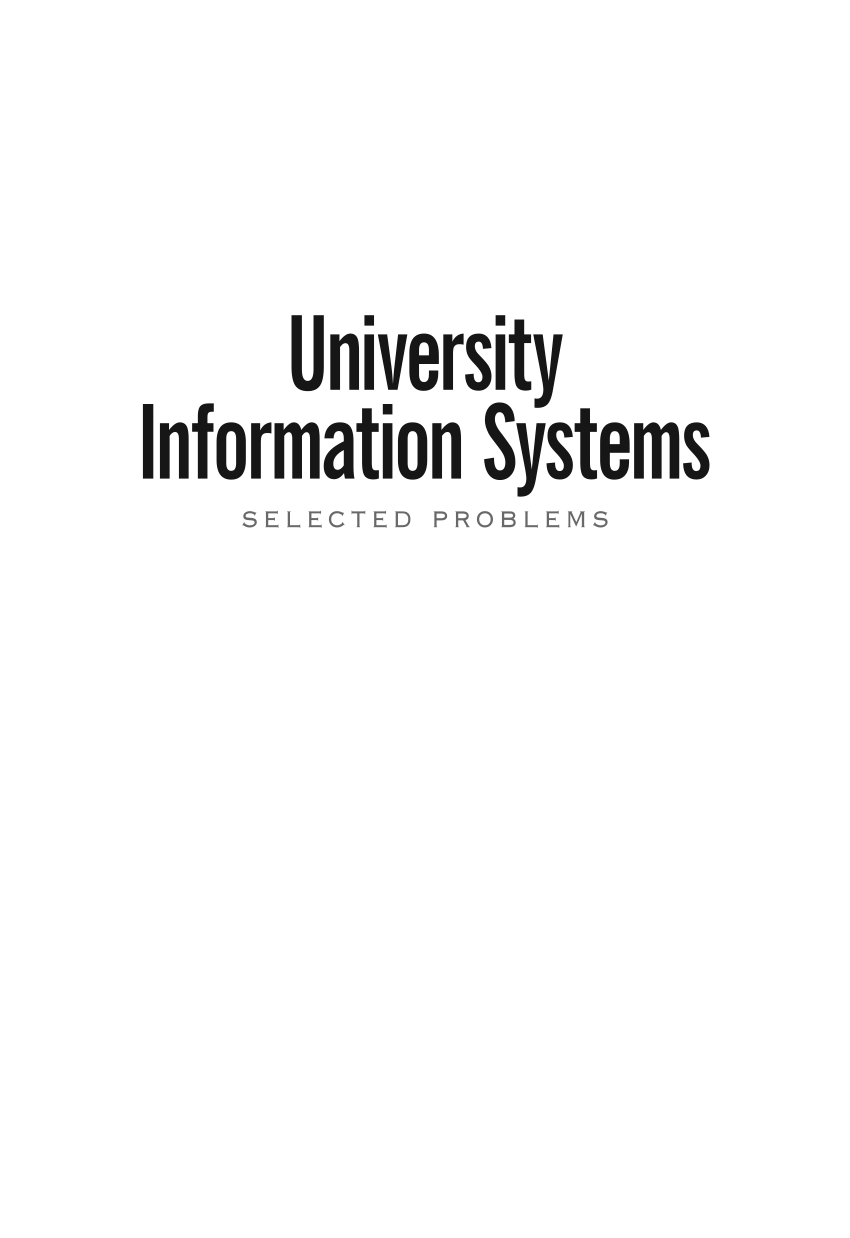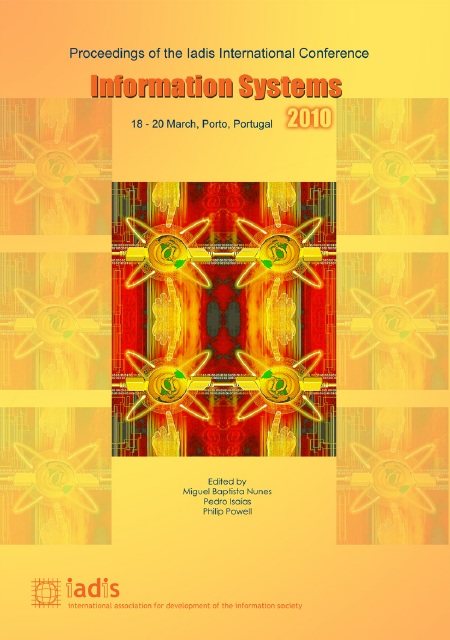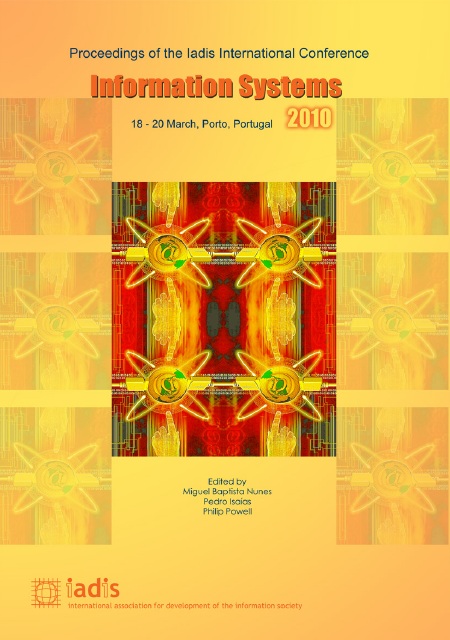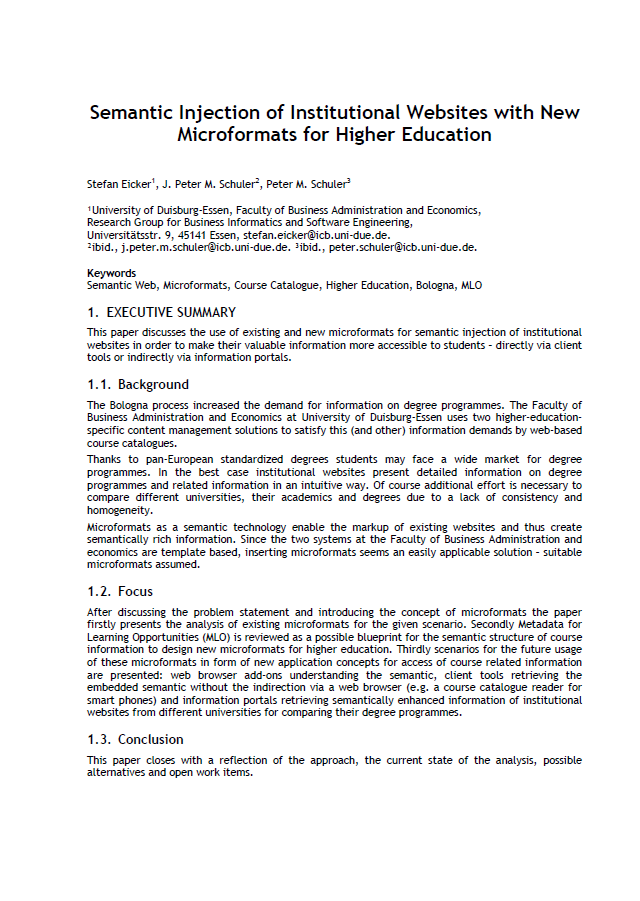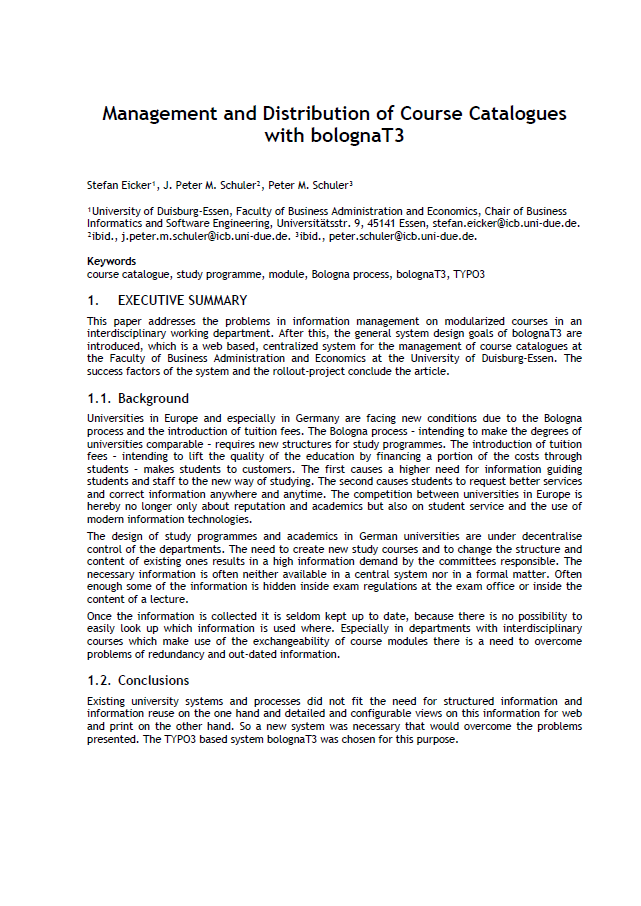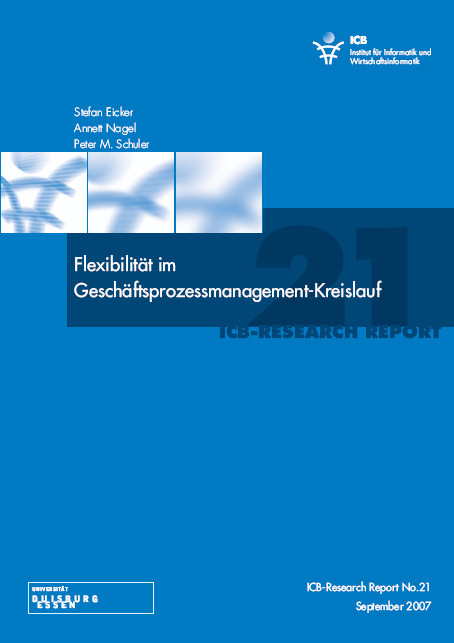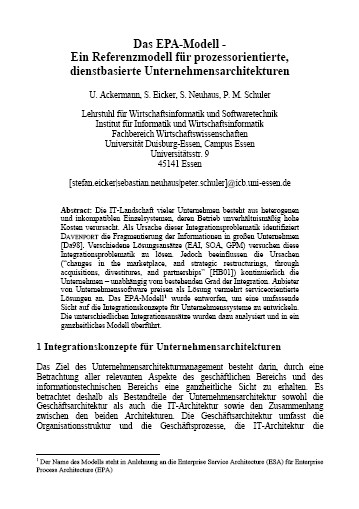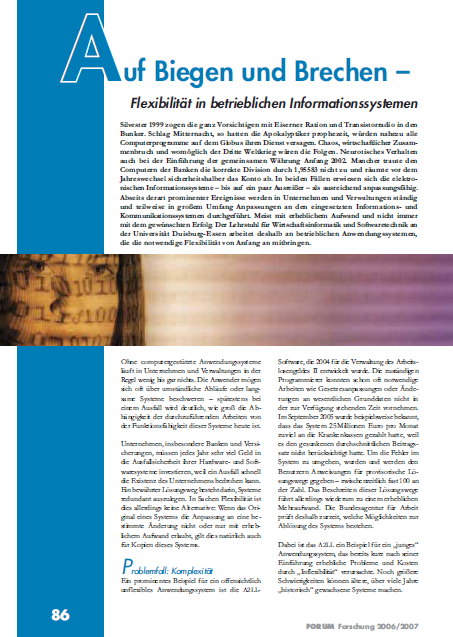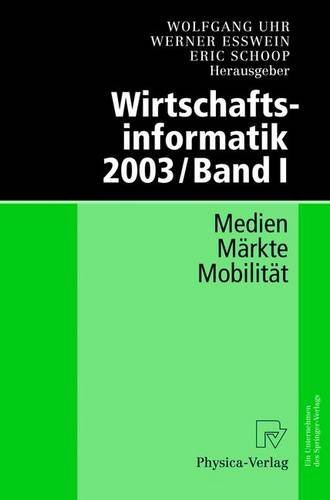Former Team Members
Curriculum Vitae:
- Januar 2013 - Mai 2016: Wissenschaftlicher Mitarbeiter am Lehrstuhl für "Wirtschaftsinformatik und Softwaretechnik" des Instituts für Informatik und Wirtschaftsinformatik am Fachbereich Wirtschaftswissenschaften der Universität Duisburg-Essen (Lehrstuhlinhaber: Prof. Dr. Stefan Eicker)
Aufgabenbereiche: Change Maker, Koordination Forschung & Lehre - Mai 2004 - Dezember 2012: Wissenschaftlicher Mitarbeiter am Lehrstuhl für "Wirtschaftsinformatik und Softwaretechnik" des Instituts für Informatik und Wirtschaftsinformatik am Fachbereich Wirtschaftswissenschaften der Universität Duisburg-Essen (Lehrstuhlinhaber: Prof. Dr. Stefan Eicker)
Aufgabenbereiche: Vielfältige Aufgaben in Forschung, Lehre und Verwaltung - Juni 2002 - April 2004: Wissenschaftlicher Mitarbeiter am Lehrstuhl für Wirtschaftsinformatik, insbes. Betriebliche Kommunikationssyteme des Fachbereichs Wirtschaftswissenschaften der Universität Essen (Lehrstuhlinhaber: Prof. Dr. Stefan Eicker)
- Aufgabenbereiche: Vielfältige Aufgaben in Forschung, Lehre und Verwaltung; insbesondere bis 12/2003 im Projekt "International Master of Business Informatics"
- Oktober 1997 - Mai 2002: Studium der Wirtschaftsinformatik an der Universität Essen mit den Schwerpunkten "Betriebliche Kommunikationssysteme", "Informationssysteme und Systemsicherheit", "Betriebswirtschaftslehre und Wirtschaftsinformatik (E-Commerce)", "Softwareorientierte Informatik"
Diplomarbeit: "Konzeption eines webbasierten Prüfungssystems"
Fields of Research:
- Informationssysteme im Gesundheitswesen
- Geschäftsprozessmanagement
- Variantenmanagement
- Wiederverwendung
- Flexible IS-Architekturen
Projects:
- Begleitung des Projektes "Knowledge Management" für die Abteilung E.ON Corporate Audit, E.ON AG, Düsseldorf (2009)
- Begleitung des Entwicklungsprojektes für ein Wissens-Management-System bei der SOPTIM AG, Essen (2007-2008)
- Einführung eines webbasierten Modulhandbuch-Informationssystems für den FB-WIWI der Universität Duisburg-Essen, Essen (2006-2008)
- Einführung eines fachbereichsweiten Content-Management-Systems für den FB-WIWI der Universität Duisburg-Essen, Essen (2006-2007)
- Redesign der Website des Landesprüfungsamtes für Erste Staatsprüfungen für Lehrämter an Schulen, Geschäftsstellen Duisburg, Essen (2006) sowie Köln (2008)
- Virtual Global University - ein BMBF-Verbundvorhaben im Rahmen des Programms "Neue Medien in der Hochschullehre": Forschungsaktivitäten für die virtuelle Wirtschaftsinformatik-Ausbildung sowie Entwurf von Kursen für den Studiengang International Master of Business Informatics (2001-2004)
Publications:
- Brunnert, Andreas; Eicker, Stefan; Schuler, Peter M.: Managing Secure System Architectures for Mobile Enterprise Applications. In: Weghorn, H.; Azevedo, L.; Isaías, P. (Ed.): Proceedings of the IADIS International Conference Applied Computing 2011. IADIS, Rio de Janeiro, Brasilien, 2011, p. 131-138. doi:10.13140/2.1.5016.2562AbstractDetailsCitation
Due to increasing spread of mobile equipment many companies face the opportunity to supply their employees with mobile enterprise applications. Since a 'mobile enterprise application' is not (!) just a 'mobile' enterprise application the selection of a suited system architecture is not trivial. Mobile enterprise applications entail different requirements (esp. concerning security), different platforms and different concepts for management. The paper analyses distinct requirements of mobile enterprise applications, discusses concepts for managing mobile enterprise applications and evaluates major mobile platforms. Thus companies get empowered to select a suited combination of platform and architecture that support the security and management requirements for their mobile enterprise application.
- Eicker, Stefan; Schuler, Peter M.: Visualizing Variability in Business Process Variant Models. In: Weghorn, H.; Azevedo, L.; Isaías, P. (Ed.): Proceedings of the IADIS International Conference Applied Computing 2011. IADIS, Rio de Janeiro, Brasilien, 2011, p. 323-330. AbstractDetailsFull textCitation
In the area of business process management, mastering variability is as important as handling re-use. This paper presents
an approach for annotating business process model activities with variant indicating attachments. Thereby, maintaining
business process variant models will become more convenient since the modeler gets presented alternatives for the
current business process model on the basis of an underlying reference process model – but without the complexity of
reference modeling itself. The presented annotation is independent of a distinct process modeling notation and works
across several views of business processes. - Eicker, Stefan; Nagel, Annett; Schuler, Peter M.: Operationalization of Flexibility in Business Process Management. In: Miguel Baptista Nunes, Pedro Isaías; Powell, Philip (Ed.): Proceedings of the IADIS International Conference Information Systems 2010. Porto, Portugal, 2010. AbstractDetailsFull textCitation
Flexibility is the argument brought forward when preparing enterprises for the (uncertain) future. As business process management (BPM) aims at the methodical design of goal-oriented business processes, the world of change added 'flexibility' to the existing goals 'quality', 'time' and 'costs'. This paper addresses the topic of flexibility focusing on BPM in order to establish a definition of flexibility suited to serve the different research areas, so far each covering flexibility with a particular view. Based on the three levels of flexibility presented in this paper an approach will be documented how business processes can be improved using these levels.
- Eicker, Stefan; Pniewski, Sabine; Schuler, Peter M.: Hard Facts, Soft Skills? Business Informatics Curricula Reviewed for Supporting a Holistic View on People, IT & Organization. In: Miguel Baptista Nunes, Pedro Isaías; Powell, Philip (Ed.): Proceedings of the IADIS International Conference Information Systems 2010. Porto, Portugal, 2010. AbstractDetailsCitation
With regard to increasing interdependencies between people, IT and organization the demand for intermediation within this area of tension rises. The question is, to what extent the current profile of Business Informatics practitioners is suited to meet this demand. In order to find an answer to this question, we analyzed the current profile of Business Informatics using a structuring model. Based on the results showing both existing and missing hard and soft facets of the profile we suggest possible building blocks for the curricula of an alternative Business Informatics profile.
- Eicker, Stefan; Schuler, J. Peter M.; Schuler, Peter M.: Semantic Injection of Institutional Websites with New Microformats for Higher Education. In: 15th International Conference of European University Information Systems (EUNIS 2009). Santiago de Compostela, Spain, 2009. AbstractPDFDetailsCitation
1. EXECUTIVE SUMMARY
This paper discusses the use of existing and new microformats for semantic injection of institutional websites in order to make their valuable information more accessible to students – directly via client tools or indirectly via information portals.
1.1. Background
The Bologna process increased the demand for information on degree programmes. The Faculty of Business Administration and Economics at University of Duisburg-Essen uses two higher-educationspecific content management solutions to satisfy this (and other) information demands by web-based course catalogues.
Thanks to pan-European standardized degrees students may face a wide market for degree programmes. In the best case institutional websites present detailed information on degree programmes and related information in an intuitive way. Of course additional effort is necessary to compare different universities, their academics and degrees due to a lack of consistency and homogeneity.
Microformats as a semantic technology enable the markup of existing websites and thus create semantically rich information. Since the two systems at the Faculty of Business Administration and economics are template based, inserting microformats seems an easily applicable solution – suitable microformats assumed.
1.2. Focus
After discussing the problem statement and introducing the concept of microformats the paper firstly presents the analysis of existing microformats for the given scenario. Secondly Metadata for Learning Opportunities (MLO) is reviewed as a possible blueprint for the semantic structure of course information to design new microformats for higher education. Thirdly scenarios for the future usage of these microformats in form of new application concepts for access of course related information are presented: web browser add-ons understanding the semantic, client tools retrieving the embedded semantic without the indirection via a web browser (e.g. a course catalogue reader for smart phones) and information portals retrieving semantically enhanced information of institutional websites from different universities for comparing their degree programmes.
1.3. Conclusion
This paper closes with a reflection of the approach, the current state of the analysis, possible alternatives and open work items.<span id="1252314128046S"> <span id="1252314278278S"> </span>
</span> - Eicker, Stefan; Schuler, J. Peter M.; Schuler, Peter M.: Semantic Injection of Institutional Websites with New Microformats for Higher Education. In: 15th International Conference of European University Information Systems (EUNIS 2009). Santiago de Compostela, Spain, 2009. AbstractPDFDetailsCitation
1. EXECUTIVE SUMMARY
This paper discusses the use of existing and new microformats for semantic injection of institutional websites in order to make their valuable information more accessible to students – directly via client tools or indirectly via information portals.
1.1. Background
The Bologna process increased the demand for information on degree programmes. The Faculty of Business Administration and Economics at University of Duisburg-Essen uses two higher-educationspecific content management solutions to satisfy this (and other) information demands by web-based course catalogues.
Thanks to pan-European standardized degrees students may face a wide market for degree programmes. In the best case institutional websites present detailed information on degree programmes and related information in an intuitive way. Of course additional effort is necessary to compare different universities, their academics and degrees due to a lack of consistency and homogeneity.
Microformats as a semantic technology enable the markup of existing websites and thus create semantically rich information. Since the two systems at the Faculty of Business Administration and economics are template based, inserting microformats seems an easily applicable solution – suitable microformats assumed.
1.2. Focus
After discussing the problem statement and introducing the concept of microformats the paper firstly presents the analysis of existing microformats for the given scenario. Secondly Metadata for Learning Opportunities (MLO) is reviewed as a possible blueprint for the semantic structure of course information to design new microformats for higher education. Thirdly scenarios for the future usage of these microformats in form of new application concepts for access of course related information are presented: web browser add-ons understanding the semantic, client tools retrieving the embedded semantic without the indirection via a web browser (e.g. a course catalogue reader for smart phones) and information portals retrieving semantically enhanced information of institutional websites from different universities for comparing their degree programmes.
1.3. Conclusion
This paper closes with a reflection of the approach, the current state of the analysis, possible alternatives and open work items.<span id="1252314128046S"> <span id="1252314278278S"> </span>
</span> 1. EXECUTIVE SUMMARY
This paper addresses the problems in information management on modularized courses in an interdisciplinary working department. After this, the general system design goals of bolognaT3 are introduced, which is a web based, centralized system for the management of course catalogues at the Faculty of Business Administration and Economics at the University of Duisburg-Essen. The success factors of the system and the rollout-project conclude the article.
1.1. Background
Universities in Europe and especially in Germany are facing new conditions due to the Bologna process and the introduction of tuition fees. The Bologna process – intending to make the degrees of universities comparable – requires new structures for study programmes. The introduction of tuition fees – intending to lift the quality of the education by financing a portion of the costs through students – makes students to customers. The first causes a higher need for information guiding students and staff to the new way of studying. The second causes students to request better services and correct information anywhere and anytime. The competition between universities in Europe is hereby no longer only about reputation and academics but also on student service and the use of modern information technologies.
The design of study programmes and academics in German universities are under decentralise control of the departments. The need to create new study courses and to change the structure and content of existing ones results in a high information demand by the committees responsible. The necessary information is often neither available in a central system nor in a formal matter. Often enough some of the information is hidden inside exam regulations at the exam office or inside the content of a lecture.
Once the information is collected it is seldom kept up to date, because there is no possibility to easily look up which information is used where. Especially in departments with interdisciplinary courses which make use of the exchangeability of course modules there is a need to overcome problems of redundancy and out-dated information.
1.2. Conclusions
Existing university systems and processes did not fit the need for structured information and information reuse on the one hand and detailed and configurable views on this information for web and print on the other hand. So a new system was necessary that would overcome the problems presented. The TYPO3 based system bolognaT3 was chosen for this purpose.<span id="1252314076270S"><span id="1252314325711S"> </span></span>
1. EXECUTIVE SUMMARY
This paper addresses the problems in information management on modularized courses in an interdisciplinary working department. After this, the general system design goals of bolognaT3 are introduced, which is a web based, centralized system for the management of course catalogues at the Faculty of Business Administration and Economics at the University of Duisburg-Essen. The success factors of the system and the rollout-project conclude the article.
1.1. Background
Universities in Europe and especially in Germany are facing new conditions due to the Bologna process and the introduction of tuition fees. The Bologna process – intending to make the degrees of universities comparable – requires new structures for study programmes. The introduction of tuition fees – intending to lift the quality of the education by financing a portion of the costs through students – makes students to customers. The first causes a higher need for information guiding students and staff to the new way of studying. The second causes students to request better services and correct information anywhere and anytime. The competition between universities in Europe is hereby no longer only about reputation and academics but also on student service and the use of modern information technologies.
The design of study programmes and academics in German universities are under decentralise control of the departments. The need to create new study courses and to change the structure and content of existing ones results in a high information demand by the committees responsible. The necessary information is often neither available in a central system nor in a formal matter. Often enough some of the information is hidden inside exam regulations at the exam office or inside the content of a lecture.
Once the information is collected it is seldom kept up to date, because there is no possibility to easily look up which information is used where. Especially in departments with interdisciplinary courses which make use of the exchangeability of course modules there is a need to overcome problems of redundancy and out-dated information.
1.2. Conclusions
Existing university systems and processes did not fit the need for structured information and information reuse on the one hand and detailed and configurable views on this information for web and print on the other hand. So a new system was necessary that would overcome the problems presented. The TYPO3 based system bolognaT3 was chosen for this purpose.<span id="1252314076270S"><span id="1252314325711S"> </span></span>
Die jüngeren Entwicklungen der Informations- und Kommunikationstechnik haben zu einer mehr und mehr globalisierten Welt geführt, in der geographische Beschränkungen entfallen und sich Unternehmen ständig neuen Herausforderungen gegenübergestellt sehen. Ein solch dynamisches Umfeld erfordert, dass sich Unternehmen an geänderte Bedingungen anpassen können – d. h. sie müssen flexibel sein. Geschäftsprozessmanagement (GPM) ermöglicht eine zielgerichtete Steuerung der Geschäftsprozesse und damit des Unternehmens. Unter der Zielsetzung des Erfolgsfaktors „Flexibilität“ untersucht der vorliegende Arbeitsbericht die Gestaltungsmöglichkeiten innerhalb des GPM.
- Ackermann, Ulf; Eicker, Stefan; Neuhaus, Sebastian; Schuler, Peter M.: Das EPA-Modell - Ein Referenzmodell für prozessorientierte, dienstbasierte Unternehmensarchitekturen. In: Lehner, F.; Nösekabel, H.; Kleinschmidt, P. (Ed.): Multikonferenz Wirtschaftsinformatik 2006, Tagungsband 2. GITO-Verlag, Berlin, 2006, p. 183-197. AbstractPDFDetailsCitation
Die IT-Landschaft vieler Unternehmen besteht aus heterogenen und inkompatiblen Einzelsystemen, deren Betrieb unverhältnismäßig hohe Kosten verursacht. Als Ursache dieser Integrationsproblematik identifiziert DAVENPORT die Fragmentierung der Informationen in großen Unternehmen. Verschiedene Lösungsansätze (EAI, SOA, GPM) versuchen diese Integrationsproblematik zu lösen. Jedoch beeinflussen die Ursachen ("changes in the marketplace, and strategic restructurings, through acquisitions, divestitures, and partnerships") kontinuierlich die Unternehmen - unabhängig vom bestehenden Grad der Integration. Anbieter von Unternehmenssoftware preisen als Lösung vermehrt serviceorientierte Lösungen an. Das EPA-Modell wurde entworfen, um eine umfassende Sicht auf die Integrationskonzepte für Unternehmenssysteme zu entwickeln. Die unterschiedlichen Integrationsansätze wurden dazu analysiert und in ein ganzheitliches Modell überführt. Der Name des Modells steht in Anlehnung an die Enterprise Service Architecture (ESA) für Enterprise Process Architecture (EPA).
Silvester 1999 zogen die ganz Vorsichtigen mit Eiserner Ration und Transistorradio in den Bunker. Schlag Mitternacht, so hatten die Apokalyptiker prophezeit, würden nahezu alle Computerprogramme auf dem Globus ihren Dienst versagen. Chaos, wirtschaftlicher Zusammenbruch und womöglich der Dritte Weltkrieg wären die Folgen. Neurotisches Verhalten auch bei der Einführung der gemeinsamen Währung Anfang 2002. Mancher traute den Computern der Banken die korrekte Division durch 1,95583 nicht zu und räumte vor dem Jahreswechsel sicherheitshalber das Konto ab. In beiden Fällen erwiesen sich die elektronischen Informationssysteme – bis auf ein paar Ausreißer – als ausreichend anpassungsfähig. Abseits derart prominenter Ereignisse werden in Unternehmen und Verwaltungen ständig und teilweise in großem Umfang Anpassungen an den eingesetzten Informations- und Kommunikationssystemen durchgeführt. Meist mit erheblichem Aufwand und nicht immer mit dem gewünschten Erfolg. Der Lehrstuhl für Wirtschaftsinformatik und Softwaretechnik an der Universität Duisburg-Essen arbeitet deshalb an betrieblichen Anwendungssystemen, die die notwendige Flexibilität von Anfang an mitbringen.
In den vergangenen Jahren hat der Einsatz des server-based Computing (SBC) aufgrund der im Vergleich zu etablierten Client-Server-Architekturen niedrigeren Total Costs of Ownership in betrieblichen Umgebungen immer mehr an Attraktivität gewonnen. Die Kombination von SBC und virtuellen Maschinen (VM) im E-Learning ermöglicht den Aufbau virtueller Computerpools, auf die die Lernenden über das Internet zugreifen. Der vorliegende Artikel skizziert die technischen Grundlagen und schildert erste Erfahrungen aus dem Einsatz virtueller Computerpools an der Virtual Global University (VGU).
Talks:
- Eicker, Stefan; Schuler, Peter M.: Wie IT die Welt verändert.... 21.01.2011, Gummersbach.
- Eicker, Stefan; Schuler, Peter M.: Business Process Variants as a Mechanism for Designing HE Information Systems. EUNIS 2010: IT - A Step forward in Higher Education, 25.06.2010, Warsaw, Poland.
- Eicker, Stefan; Schuler, J. Peter M.; Schuler, Peter M.: Designing Microformats for Higher Education - Between Semantic Richness and Standardization. EUNIS 2010: IT - A Step forward in Higher Education, 24.06.2010, Warsaw, Poland.
- Eicker, Stefan; Nagel, Annett; Schuler, Peter M.: Operationalization of Flexibility in Business Process Management. IADIS International Conference Information Systems 2010, 19.03.2010, Porto, Portugal.
- Eicker, Stefan; Pniewski, Sabine; Schuler, Peter M.: Hard Facts, Soft Skills? Business Informatics Curricula Reviewed for Supporting a Holistic View on People, IT & Organization. IADIS International Conference Information Systems 2010, 18.03.2010, Porto, Portugal.
- Eicker, Stefan; Schuler, J. Peter M.; Schuler, Peter M.: Semantic Injection of Institutional Websites with New Microformats for Higher Education. EUNIS 2009 - IT: Key of the European Space for Knowledge, 24.06.2009, Santiago de Compostela, Spain.
- Eicker, Stefan; Schuler, J. Peter M.; Schuler, Peter M.: Management and Distribution of Course Catalogues with bolognaT3. EUNIS 2008 - Visions for IT in Higher Education, 26.06.2008, Århus, Denmark.
- Eicker, Stefan; Kochbeck, Jessica; Schuler, Peter M.: Employee Competencies for Business Process Management. 11th International Conference on Business Information Systems, 06.05.2008, Innsbruck, Austria. Abstract
Business process management (BPM) is an approach which empowers companies to react flexibly to new market situations. The main goal of BPM is to improve efficiency and effectiveness of value-adding business processes. The changes caused by globalization do not only concern organization, technologies and processes, but also people. Employee competencies can be crucial competitive advantages.
The need for new specialized and competent personnel in BPM becomes apparent from the definition of new roles, such as “Chief Process Officer” (CPO). Field reports and surveys reveal that role concepts of BPM have so far not been completely established, due to a lack of appropriate structures or dueto resistance within the companies.
This article considers and analyzes the success factor employee competencies in matters of the implementation of BPM in companies. For this purpose, competencies which are necessary for the roles in BPM are identified. Moreover, a classification method for the definition of role profiles is developed. - Schuler, Peter M.: Creating Content. E-University Workshop-Reihe: E-Learning-Szenarien in Betriebswirtschaft und Wirtschaftswissenschaften, 19.05.2006, Duisburg.
- Eicker, Stefan; Schuler, Peter M.; Gartner, Thomas: Einsatz virtueller Computer-Pools im E-Learning. 6. Internationale Tagung Wirtschaftsinformatik 2003: Medien - Märkte - Mobilität, 18.09.2003, Dresden. Abstract
Courses:
- Digitale Transformation
- Moderne Informationssystemlandschaften
- Enterprise Architecture Management
- Fortgeschrittene Programmierkonzepte
- Enterprise Application Integration
- Website Engineering 1
- Kommunikationsnetze und Middleware
- C# und das .NET Framework
- Informations- und Kommunikationssysteme, Internet
- Wirtschaftsinformatik II
- Distributed Business Information Systems
- Website Engineering Fundamentals
- C++ Anwendung
Tutored Theses:
- Industrie 4.0 - Prozessoptimierung in der Produktion & Logistik mit Bluetooth Tags und SAPUI5 (Master Thesis Business Information Systems, 2019)
- Successful Implementation of an E-Commerce Platform using SAP Hybris: How to Use Agile Project Management Methodologies in the Context of Digital Transformation (Master Thesis Business Information Systems, 2019)
- Towards a European platform of civil society's organizations: Generating public value through interoperable open government data (Master Thesis Business Information Systems, 2018)
- Digitale Transformation kommunaler Verwaltung – der Einsatz von Consulting im Spannungsfeld von Wandel und Stabilität (Master Thesis Business Information Systems, 2018)
- Integration von Self-Service Business Intelligence in die IT Governance am Beispiel des COBIT Frameworks (Master Thesis Business Information Systems, 2018)
- Integration einer Workflowengine in das Bankverfahren agree21 zur Unterstützung omnikanalfähiger Geschäftsprozesse und deren Individualisierung (Master Thesis Business Information Systems, 2018)
- Monetarisierung von Information Assets: Information Governance und Information Asset Management als Enabler (Master Thesis Business Information Systems, 2018)
- Analyse von Möglichkeiten zur Modellierung klinischer Pfade mit BPMN, CMMN und DMN (Master Thesis Business Information Systems, 2018)
- Analyse des Digitalisierungspotentials bei der Siemens Healthcare GmbH am Beispiel Learning-Management (Master Thesis Business Information Systems, 2018)
- Entwurf einer Referenzarchitektur für cloudbasierte Webanwendungen unter Berücksichtigung des Softwareentwicklungsprozesses (Master Thesis Business Information Systems, 2017)
- Entwurf von Qualifizierungsmaßnahmen für Projektmitarbeiter am Beispiel einer Einführung von SAP S/4HANA (Master Thesis Business Information Systems, 2017)
- Digitale Transformation von IT-Beratungsleistungen: Entwurf einer digitalen Service-Plattform für das SAP Beratungsgeschäft (Master Thesis Business Information Systems, 2017)
- Beyond Predictive Analytics: Towards a process Model for Implementing Prescriptive Analytics (Master Thesis Business Information Systems, 2017)
- Entwurf eines Mobile-App-Developement-Life-Cycles für die Cross-Plattform-Entwicklung und Analyse unterstützender Tools (Master Thesis Business Information Systems, 2017)
- Untersuchung und Analyse der LMIV 1169/2011, sowie deren Umsetzung in einem PIM-System, unter Berucksichtigung eines standardisierten Stammdatenpools (Master Thesis Business Information Systems, 2017)
- Strategische Bebauungsplanung in der Logistik bei E+H (Master Thesis Business Information Systems, 2016)
- ITIL für kleine Organisationen im öffentlichen Dienst - Erarbeitung von Empfehlungen zur Verbesserung der Prozesse eines Service-Desk-Standorts (Master Thesis Business Information Systems, 2016)
- Erfolgsfaktoren für die Einführung der elektronischen Akte in der Landesverwaltung Baden-Württemberg (Master Thesis Business Information Systems, 2016)
- Digital Customer Experience - Identifikation von Gestaltungsmaßnahmen zur digitalen Transformation der Kundenerfahrung (Bachelor Thesis Business Information Systems, 2016)
- Entwurf eines Kriterienkatalogs für die Evaluation von Ansätzen zum Management variantenreicher Geschäftsprozesse (Master Thesis Business Information Systems, 2016)
- Entwurfsprinzipien der digitalen Transformation - Konzeption eines Ordnungsrahmens zur Gestaltung von Digitalisierungsstrategien (Master Thesis Business Information Systems, 2016)
- Analyse der Auswirkungen von BI-Trends auf BI-Architekturen unter Berücksichtigung von Big-Data-Konzepten (Master Thesis Business Information Systems, 2016)
- Geschäftsprozessmanagement mit Raumbezug – Analyse der Geschäftsprozesse von Infrastrukturbetreibern in Hinblick auf die Unterstützung durch Geoinformationssysteme (Arbeitstitel) (Master Thesis Business Information Systems, 2016)
- Digitale Transformation im Gesundheitswesen - Analyse des Einsatzes von Informationssystemen in der Patient-Empowerment-Bewegung (Bachelor Thesis Business Information Systems, 2016)
- Versionierung von Geschäftsprozessmodellen - Adaption etablierter Konzepte aus der Softwareentwicklung für BPMN-Prozessmodelle (Master Thesis Business Information Systems, 2016)
Geschäftsprozesse leben. Sie müssen sich mit verändernden Anforderungen weiterentwickeln. Dies hat zur Folge, dass zu einem Geschäftsprozess über den zeitlichen Verlauf mehrere, auch parallel gültige Geschäftsprozesse existieren (z.B. aufgrund von Übergangszeiten neuer rechtlicher Anforderungen entstehende Gültigkeitsspannen für Artefakte). Ziel dieser Arbeit ist es, aus der Softwareentwicklung etablierte Konzepte zur Versionierung (z.B. GitFlow) auf Geschäftsprozessmodelle zu übertragen, um die Versionierung von Veränderungen in Geschäftsprozessen besser zu unterstützen (auch für Geschäftsregeln und Abhängigkeiten zwischen Bausteinen). Dabei soll berücksichtigt werden, dass Änderungen an Subprozessen oder Aktivitäten evtl. ohne aktive Veränderung des Hauptprozesses vorgenommen werden - so aber indirekt zu einer neuen Version des Hauptprozesses führen können.
(Als Basis-Notation soll BPMN verwendet werden. Ein fachliches Beispiel für eine Prozessfamilie ist nicht vorgegeben.)
- Der Einfluss der digitalen Transformation auf die Arbeitswelt (Bachelor Thesis Business Information Systems, 2016)
- Customer Relationship Management im Mittelstand - Umsetzung eines Proof-of-Concepts für die Einführung von Microsoft Dynamics CRM in einem Mittelstandsunternehmen (Bachelor Thesis Business Information Systems, 2016)
- Enterprise Application Integration - Erfolgsfaktoren für eine Prozessintegration mit SAP Netweaver (Bachelor Thesis Business Information Systems, 2015)
- Analyse von Einführungsstrategien für Enterprise Architecture Frameworks am Beispiel verschiedener Fallstudien (Bachelor Thesis Business Information Systems, 2015)
- Marshalling Data, Events and UI: A proposal on how to reduce boilerplate code in Android application development (Bachelor Thesis Computer Science, 2015)
- Integration as a Service: Enterprise Application Integration in Times of Cloud Computing (Bachelor Thesis Business Information Systems, 2015)
- Possibilities and Limitations of Information Extraction from Social Media Big Data (Master Thesis Business Information Systems, 2015)
- Visualisierungskonzepte für Ontologien zur Erkundung von Wissen (Bachelor Thesis Business Information Systems, 2015)
- Designing a Fitness Application Using Game Design Elements to Increase Motivation (Bachelor Thesis Business Information Systems, 2014)
- Big Data in practice: Analysing selected projects in Marketing (Bachelor Thesis Business Information Systems, 2014)
- Entwurf eines Vorgehensmodells für das Service Systems Engineering (Master Thesis Business Information Systems, 2014)
- Entwurf einer Geschäftsprozessfamilie für das Retourenmanagement im Online-Handel (Master Thesis Business Information Systems, 2014)
- Design of Guidelines for ABAP Software Development in the Context of the Implementation of SAP ERP 6.0 (Master Thesis Business Information Systems, 2014)
- Berücksichtigung rechtlicher Anforderungen beim Entwurf mobiler Anwendungen im Gesundheitswesen (Master Thesis Business Information Systems, 2014)
- Entwurf eines generischen Anforderungskatalogs für Enterprise Cloud Integration (Bachelor Thesis Business Information Systems, 2014)
- Vergleich von traditionellem Data Warehousing und In-Memory Technologie basierend auf den Anforderungen im Treasury der WGZ Bank (Bachelor Thesis Business Information Systems, 2014)
- Development of a change management concept for pharmaceutical companies and evaluation of potentially suitable SAP tools (Master Thesis Business Information Systems, 2014)
- Verbesserung der intersektoralen Patientenversorgung zwischen Krankenhaus und stationärer Pflege durch Konzeption und Realisierung eines EFA-basierten Pflege-Mehrwertdienstes (Bachelor Thesis Business Information Systems, 2014)
- eHealth Literacy - Zielführende Nutzung elektronischer Gesundheitsinformationen durch Patienten (Bachelor Thesis Business Information Systems, 2014)
- Mitarbeiterführung in der Wirtschaftsinformatik – Soziale Effekte von Informationssystemen (Master Thesis Business Information Systems, 2014)
- Towards a framework for analysing industry-specific IS landscapes: Applying concepts of Enterprise Architecture to describe selected industrial sectors (Master Thesis Business Information Systems, 2014)
- Analyse potenzieller Vertriebswege zum Einstieg in den Online-Handel für in Kleinauflage hergestellte Textil-Produkte (Bachelor Thesis Business Information Systems, 2014)
- IT-Governance im Krankenhaus - Managen der Informationssicherheit unter Einsatz von COBIT5 (Bachelor Thesis Business Information Systems, 2013)
- Konzeption einer Prognoseanwendung zur Verbesserung der Netzstabilität von Smart Grids im deutschen Strom- und Gasmarkt (Master Thesis Business Information Systems, 2013)
- Kommunikationsinstrumente für erfolgreiches Change Management in IT-Projekten (Master Thesis Business Information Systems, 2013)
- Von der Produktion bis zur Auslieferung - Einsatz der Balanced Scorecard für die Nachhaltigkeit von Prozessen und ihr Optimierungspotenzial (Bachelor Thesis Business Information Systems, 2013)
- Visualisierung von Software-Architekturen in heterogenen IT-Systemlandschaften - Marktüberblick und Kriterien für die Softwareauswahl (Master Thesis Business Information Systems, 2013)
- Unterstützung medizinischer Abläufe im stationären Umfeld eines Krankenhauses durch Einsatz von Tablet-PCs – Anforderungsanalyse und Konzeption eines fachlichen Prototyps (Master Thesis Business Information Systems, 2013)
- Preventing knowledge loss caused by staff turnover in university research groups: Analyzing social media from a knowledge management perspective (Master Thesis Business Information Systems, 2013)
- Entwurf und Einführung eines Data Marts auf der Basis eines OLAP-Systems zur Verbesserung des Unternehmensreportings am Beispiel des Industrial Sales Bereiches der RWE Supply & Trading GmbH (Master Thesis Business Information Systems, 2013)
- Entwurf und Evaluation einer Architektur für Business-Intelligence-Informationssysteme auf der Grundlage von In-Memory-Datenbanken (Master Thesis Business Information Systems, 2013)
- Analyse des Potenzials der Einbindung dezentraler Lifestyle- und Gesundheitsdaten in medizinische Behandlungspfade durch eine integrierte Informationsarchitektur (Master Thesis Business Information Systems, 2013)
- Analyse der Eignung von Case Management und Geschäftsprozessmangement zur Unterstützung medizinischer Behandlungspfade (Master Thesis Business Information Systems, 2012)
- Erweiterung des BPMN-Prozessdiagramms um Konzepte zur Modellierung von Variabilität (Master Thesis Business Information Systems, 2012)
- State-of-the-Art und zukünftige Entwicklung des Ambient Assisted Living in Deutschland (Bachelor Thesis Business Information Systems, 2012)
- Integration des Prozesses zur Funktionalen Sicherheit in PKW nach ISO 26262 mit Methoden und Tools des Anforderungsmanagements (Master Thesis Business Information Systems, 2012)
- Kanban als Managementinstrument für verteilte Teams (Bachelor Thesis Business Information Systems, 2012)
- IT-Management im Finanzdienstleistungssektor – Ein Zusammenspiel von Bankstrategie, IT-Strategie und Mitarbeitern (Master Thesis Business Information Systems, 2012)
- Refactoring von Geschäftsprozessmodellen (Master Thesis Business Information Systems, 2011)
- Integration von mobilen Anwendungen in existierende Unternehmensarchitekturen (Master Thesis Business Information Systems, 2011)
- Anwendung der orthogonalen Variabilitätsmodellierung auf die Referenzmodellierung von Geschäftsprozessen (Master Thesis Business Information Systems, 2011)
- Incident-Management nach ITIL in einer zentral-dezentralen IT-Organisation - Konzeption einer Implementierung am Beispiel der Finanzverwaltung NRW (Master Thesis Business Information Systems, 2011)
- Komplexitätsmanagement bei Geschäftsprozessen (Master Thesis Business Information Systems, 2010)
The scope of this master thesis is complexity management within business processes and aims to give a synoptic insight into this field. The complexity in enterprises is driven by external and internal factors. The effects of this complexity concern the processes themselves and aditionally they create complexity costs which cannot be assigned correctly. Complexity management therefore targets to reduce complexity as far as possible and to improve the handling of the residual complexity.
Various technologies are used to support the complexity management of business processes. Languages with specific symbols and a propriate syntax are used in order to simplify the modelling of processes. Very important is the automated execution of business processes, e.g. by workflow management systems. Service Oriented Architecture (SOA), is an aditional technology to create more flexible business processes. Modularity, standardization and loose coupling of services are important characteristics of this architecture.
Standard technologies for realization of business processes are limited especially concerning their flexibility, so advanced concepts are needed. The language YAWL is another approach to model complex processes with an easy –to-understand syntax. Adaptive process management consists of technologies -mainly still in development – to give a maximum of flexibility, for instance ad-hoc runtime-process changes. ADEPT, DECLARE and FLOWer are examples covered by this work. PROVOP is another concept targeting the realization of variants.
Die vorliegende Masterarbeit beschäftigt sich mit dem Komplexitätsmanagement von Geschäftsprozessen und hat das Ziel, einen umfassenden Einblick in diese Thematik zu geben. Im Grundlagenteil werden die für das Verständnis relevanten Begriffe, Komplexität, Management und Geschäftsprozesse definiert. Verursacht wird die Komplexität durch unternehmensexterne und –interne Komplexitätstreiber. Die Auswirkungen betreffen zum einen die Prozesse selbst. Es entstehen aber vor allem Komplexitätskosten, die nicht mehr verursachungsgemäß zugeordnet werden können. Im Rahmen des Komplexitätsmanagements geht es deshalb darum, Komplexität weitgehend zu reduzieren und die verbleibende Restkomplexität besser zu beherrschen.
Zur Unterstützung des Komplexitätsmanagement von Geschäftsprozessen finden verschiedene Technologien Verwendung. Um die Prozesse vereinfacht in einem Modell abbilden zu können, werden Modellierungssprachen mit spezifischen Symbolen und einer entsprechenden Syntax benutzt. Von großer Bedeutung ist die automatisierte Ausführung der Geschäftsprozesse, beispielsweise durch Workflow-Management-Systeme. Eine weitere Technologie, um Geschäftsprozesse flexibler zu gestalten, stellt die Service Oriented Architecture (SOA) dar, die auch mit Web Services realisiert werden kann. Wichtige Merkmale sind in diesem Zusammenhang die Modularität, die lose Kopplung sowie die Standardisierung von Services.
Da die Standardtechnologien zur Realisierung von Geschäftsprozessen gerade hinsichtlich der Flexibilisierung an ihre Grenzen stoßen, wird nach weiterführenden Konzepten gesucht. Bei den Modellierungssprachen stellt YAWL einen Ansatz dar, um mit einer leicht verständlichen Syntax komplexe Prozesse abbilden zu können. Adaptives Prozessmanagement umfasst Technologien, die größtenteils noch in der Entwicklung sind und ein Maximum an Flexibilität, beispielsweise Ad-hoc Prozessänderungen zur Laufzeit, ermöglichen sollen. ADEPT, DECLARE und FLOWer sind die Beispiele, die in der vorliegenden Arbeit behandelt werden. PROVOP ist ein weiterer Ansatz, der die Realisierung von Varianten zum Ziel hat.
- Möglichkeiten der Effizienzsteigerung und Erhöhung der Sicherheit durch Flughafen Vorfeld Telematik (Master Thesis Business Information Systems, 2010)
- Management von Varianten in Referenzmodellen und Software-Produktlinien (Bachelor Thesis Business Information Systems, 2010)
- Evolution von Geschäftsprozessmodellen (Bachelor Thesis Business Information Systems, 2010)
- Einsatz von Patterns bei der Optimierung von Geschäftsprozessen (Bachelor Thesis Business Information Systems, 2010)
- Komplexitätsmanagement zur Optimierung IT-basierter Geschäftsprozesse (Bachelor Thesis Business Information Systems, 2010)
- Vermindern der Ausfallzeit von Services bei der Weiterentwicklung von SOA-Systemen (Master Thesis Business Information Systems, 2010)
- Konzeption von Mikroformaten für die akademische Bildung (Diploma Thesis Business Information Systems, 2010)
- Erfolgsfaktoren der Softwareentwicklung und deren Einsatz zur Bewertung justizinterner Softwareprojekte (Master Thesis Business Information Systems, 2010)
- Geschäftsprozessanalyse und Optimierung am Beispiel des Auftragsmanagements eines Kompetenz-Centers (Diploma Thesis Business Information Systems, 2010)
Diese Arbeit beschäftigt sich mit dem Thema der Geschäftsprozessanalyse und Optimierung am praktischen Beispiel des Auftragsmanagements eines Kompetenz- Centers, das einem großen Energiekonzern angehört. Das Auftragsmanagement beschreibt verwaltungstechnische Aufgaben im Angebots- und Auftragsabwicklungsprozess, die es gilt hinsichtlich der Durchlaufzeit zu optimieren und auf die Einhaltung der Konzernrichtlinien zu prüfen.
Zunächst wird auf das unterschiedliche Verständnis von Geschäftsprozessen eingegangen. Die Grundlagen des Geschäftsprozessmanagements werden vorgestellt und die Arbeit wird in das Thema eingeordnet. Das Aufzeigen eines ersten Konzeptes zur Optimierung von Prozessen schließt den Grundlagenteil ab.
Im nächsten Abschnitt stellt die Arbeit ein Vorgehensmodell vor, in dem die grundlegenden Phasen, die einzelnen Aktivitäten sowie ausgewählte Techniken zur Geschäftsprozessoptimierung aufgezeigt werden.
Anschließend wird auf Basis des Vorgehensmodells die Analyse und Optimierung des Auftragsmanagements durchgeführt. Die Prozesse werden aufgenommen, dargestellt, analysiert und gewürdigt. Die Entwicklung eines Ansatzes zur Optimierung und die anschließende Gestaltung des optimierten Auftragsmanagements schließen die Arbeit ab.
- Methodenkonfiguration für die maßgeschneiderte Einführung von Geschäftsprozessmanagement am Beispiel der SAP Business Process Management Methodology (Diploma Thesis Business Information Systems, 2009)
- Enterprise 2.0 als Erfolgsfaktor für die Interne Revision - am Beispiel der E.ON Corporate Audit (Diploma Thesis Business Information Systems, 2009)
- Semantisches Wissensmanagement für die E.ON AG - Konzeption einer Ontologie für die Interne Revision (Diploma Thesis Business Information Systems, 2009)
- Verfügbarkeit in ITIL V3 (Master Thesis Business Information Systems, 2009)
- Enterprise 2.0 - Web 2.0 für Unternehmen am Beispiel der GAD e.G. (Master Thesis Business Information Systems, 2009)
- Analyse der Prozessveränderungen im Zuge der Einführung eines neuen Anwendungssystems für die Tarifverdienststatistik im Statistischen Bundesamt (Master Thesis Business Information Systems, 2009)
One of the Federal Statistical Office's tasks is the provision of statistical information on trends in agreed earnings in Germany. It is in this context that the unit responsible, the Tarifverdienststatistik (Statistics on Agreed Earnings) unit, has taken delivery of a new tailor-made IT system: the Tarifdatenbank (Database on Agreed Earnings). The system's two main goals are to improve accessibility for the public to statistics on agreed earnings and to improve work efficiency for employees at the Statistical Office in maintaining this data. The implementation of the Tarifdatenbank has had a substantial impact on business processes in the department. In this master’s thesis, these changes are identified and then displayed using Business Process Modelling Notation (BPMN), and an analysis is made of the new system's effects on employees' daily work. Finally, further potential improvements to existing processes are suggested.
Eine Aufgabe des Statistischen Bundesamtes ist die Bereitstellung von statistischen Informationen über die Entwicklung der Tarifverdienste in Deutschland. In diesem Zusammenhang erhält das zuständige Referat Tarifverdienststatistik ein neues, auf seine Bedürfnisse zugeschnittenes Anwendungssystem, das die Tarifstatistik über eine Webanwendung einer breiteren Öffentlichkeit zugänglich machen und zugleich die Effizienz der Pflege der statistischen Daten steigern soll. Mit der Einführung der Tarifdatenbank gehen erhebliche Veränderungen bei den Geschäftsprozessen im Referat einher. In der vorliegenden Masterarbeit werden diese Veränderungen unter Verwendung der Business Process Modeling Notation (BPMN) aufgezeigt und die Effekte der Tarifdatenbank auf die tägliche Arbeit der Sachbearbeiter analysiert. Darüber hinaus wird auf weitere Verbesserungsmöglichkeiten in den Prozessen hingewiesen.
- Im Spannungsfeld von Mensch, IT und Organisation - Neubetrachtung des Profils von Wirtschaftsinformatikern unter Berücksichtigung harter und weicher Aspekte (Master Thesis Business Information Systems, 2009)
With regard to strengthened interdependencies between people, IT and organization the demand for intermediation within this area of tension is increasing. The question arises, to what extent the current profile of Business Informatics practitioners is suitable as a response to this demand. In order to find an answer to this question, an analysis of the profile is conducted using a structuring model. For this purpose the Business Informatics practitioners’ problem focus and tasks are being considered and general ways of thinking and acting are outlined. It is also examined, which knowledge resources (e.g. theories, methods) the Business Informatics and its reference disciplines offer to them. The results show, that Business Informatics practitioners mainly focus on the tension field’s hard (e.g. visible, objective and techno-economical) facets. This can be observed in what they do, how they do it and in the conceptions underlying their thinking and acting. Soft (e.g. latent, subjective and social) aspects are rather neglected. In principle the present profile of Business Informatics practitioners seems to be suitable for the intermediation function, being however incomplete. Therefore suggestions for an alternative profile are developed alongside the structuring model. This alternative profile captures a holistic view upon the area of tension and equally considers hard and soft aspects. Thus it is suited better to comply with the demand for intermediation. In the resulting outline of the profile, insights of further disciplines like psychology or organizational theory are taken into account and alternative ways of thinking and principles of acting are presented. The developed suggestions especially include approaches of systemic thinking and acting and show that these could offer useful contributions in the context of intermediation. Basically it becomes clear, that in the alternative profile not only the doing is crucial, but particularly the understanding and the Business Informatics practitioners’ general attitude.
Hinsichtlich zunehmender Wechselwirkungen zwischen Mensch, IT und Organisation erhöht sich der Vermittlungsbedarf innerhalb dieses Spannungsfeldes. Es stellt sich die Frage, inwiefern das Profil von Wirtschaftsinformatikern, so wie es gegenwärtig ausgeprägt ist, den damit verbundenen Anforderungen gerecht wird. Für eine diesbezügliche Analyse des Profils werden entlang eines Strukturierungsmodells etwa der Problemfokus von Wirtschaftsinformatikern betrachtet, generelle Denk- und Handlungsweisen skizziert und es wird untersucht, welche Wissensressourcen (z. B. Theorien, Methoden) ihnen über die Wirtschaftsinformatik und ihre Referenzdisziplinen zur Verfügung gestellt werden. Die Ergebnisse lassen erkennen, dass Wirtschaftsinformatiker in dem was sie tun, wie sie es tun und in den Vorstellungen, die ihrem Denken und Handeln zugrunde liegen, stark an den harten (d. h. etwa sichtbaren, objektiven und technisch-ökonomischen) Facetten des Spannungsfeldes orientiert sind. Weiche (d. h. etwa latente, subjektive und soziale) Aspekte werden hingegen vernachlässigt. Das gegenwärtige Profil von Wirtschaftsinformatikern scheint in Hinblick auf eine Vermittlerfunktion prinzipiell geeignet, jedoch unvollständig zu sein. Entlang des Strukturierungsmodells werden daher Vorschläge für ein alternatives Profil entwickelt, das einen ganzheitlichen Blick auf das Spannungsfeld wirft, dabei gleichermaßen harte wie weiche Aspekte berücksichtigt und so besonders dazu geeignet ist, dem Vermittlungsbedarf nachzukommen. In der resultierenden Profilskizze werden verstärkt Erkenntnisse weiterer Referenzdisziplinen wie etwa der Psychologie und Organisationstheorie berücksichtigt und alternative Denkweisen und Handlungsprinzipien vorgestellt. Die entwickelten Vorschläge beziehen speziell auch systemische Denk- und Handlungsansätze ein und lassen erkennen, dass diese im Kontext der Vermittlung hilfreiche Beiträge leisten können. Grundsätzlich wird deutlich, dass im alternativen Profil nicht nur das Machen, sondern insbesondere auch das Verstehen und die Grundhaltung von Wirtschaftsinformatikern einen hohen Stellenwert besitzen.
- Prozessorientierte Anwendungsintegration in Energieversorgungsunternehmen vor dem Hintergrund des regulierten Energiemarktes (Master Thesis Business Information Systems, 2009)
<meta http-equiv="Content-Type" content="text/html; charset=utf-8" /><meta name="ProgId" content="Word.Document" /><meta name="Generator" content="Microsoft Word 12" /><meta name="Originator" content="Microsoft Word 12" />
- Versionsabhängige und sukzessive Inbetriebnahme von Webanwendungen - Entwicklung eines Web-Rollout-Steuerungssystems mit Apache Webserver und Spring (Master Thesis Business Information Systems, 2009)
- Analyse der Variantenmanagement-Konzepte in der Geschäftsprozess-Referenzmodellierung (Master Thesis Business Information Systems, 2008)
The support in reference modelling by creating of variants represents a current field of study in business-informatics. The present master thesis shows, that the adaption of reference models related to the context of utilization is a complex task of contemporary modelling activities. There is a need to support the adaption by expanding the modelling languages and methods by adding extra language, engineering technologies and artefacts in order to visualize these model-variants. On the basis of an analysis there is a comparison of two main contrary and complemental variant management approaches regarding containing concepts by classifiing and valuational criteria. The analysis contains configurable reference models as representatives of proactive variants constructions and buildingblocks based on reference models as representatives of reactive compositional variants construction. Finally the questions will be answered about possible fields of application and the ability of combination.
Die Unterstützung der Referenzmodellierung durch Bildung von Varianten stellt ein aktuelles Untersuchungsfeld der Wirtschaftsinformatik dar. Die vorliegende Masterarbeit belegt, dass die Anpassung von Referenzmodellen abhängig von ihren Anwendungskontexten eine aufwendige Aufgabe gegenwärtiger Modellierungspraxis darstellt. Es besteht Bedarf zur Anpassungsunterstützung durch Erweiterung der Modellierungssprachen und -methoden um Sprachzusätze, Konstruktionstechniken und Artefakte zur Darstellung dieser Modellvarianten. Auf der Basis einer Analyse werden zwei zentrale, gegensätzliche und ergänzende Variantenmanagement-Ansätze bzgl. enthaltener Konzepte nach klassifizierenden und bewertenden Kriterien verglichen. Die Untersuchung beinhaltet konfigurierbare Referenzmodelle als Repräsentanten proaktiver adaptiver Variantenbildung und bausteinbasierte Referenzmodelle als Repräsentanten reaktiver kompositorischer Variantenbildung. Abschließend werden Fragen der Einsatzmöglichkeiten und der Kombinationsfähigkeit thematisiert.
- Geschäftsprozessoptimierung durch Nutzung von intelligenten Kommunikationsinfrastrukturen (Master Thesis Business Information Systems, 2008)
- Change Management als Erfolgsfaktor für das Geschäftsprozessmanagment mit Six Sigma (Diploma Thesis Business Information Systems, 2008)
- Integration von Wissens- und Geschäftsprozessmangement zur Unterstützung organisationalen Wandels (Diploma Thesis Business Information Systems, 2008)
- Analyse der Anwendungsmöglichkeiten der ARIS-Methodik bei der Konzeption von Software-Produktlinien (Master Thesis Business Information Systems, 2008)
- Konzepte zur Identifikation und Behebung von Prozessschwachstellen im Kontext des Geschäftsprozessmanagements (Diploma Thesis Business Information Systems, 2008)
- Flexibilitätspotenziale im Geschäftsprozessmanagmentkreislauf (Diploma Thesis Business Information Systems, 2008)
- Flexibilitätsmanagement in strukturierten Geschäftsprozessen - Eine Analyse am Beispiel eines Prozesses in der gesetzlichen Krankenversicherung (Master Thesis Business Information Systems, 2008)
- Analyzing the Effectiveness of Organizational Change Management: The Human Dimension of SAP Implementations (Diploma Thesis Business Information Systems, 2008)
- Aspekte des barrierefreien Betriebs von TYPO3 mit dem Schwerpunkt der Pflege von Inhalten (Master Thesis Business Information Systems, 2008)
- IT-Alignment in dezentralen Organisationen am Beispiel einer Universität (Diploma Thesis Business Information Systems, 2007)
Als Kontext der geplanten Diplomarbeit sollen die für die Universität üblichen dezentralen Organisationsstrukturen, sowie die primären und sekundären Tätigkeiten die im Rahmen der Aufgaben einer Universität anfallen (nach Hochschulrahmengesetz) aufgezeigt und den Organisationseinheiten zugeordnet werden. Dabei sollen vor allem auch die verschiedenen internen und externen Stakeholder der Universität vorgestellt werden sowie deren Rollenentwicklung. Anhand der Aufgaben, Stakeholder und Organisationseinheiten sollen IT-technische, informationstechnische und organisatorische Hoheitsgebiete thematisiert werden sowie auf Anforderungen an zentrale und dezentrale Systeme eingegangen werden für das IT-Alignment.
Zur Veranschaulichung war die Überlegung ein zentrales Fallbeispiel zu nehmen – und zwar den Prozess der studienbegleitenden Prüfungen (im Fachbereich WiWi speziell, bzw. allgemein an der UDE). In diesem Prozess wären verschiedene IT-Systeme, Personen und Organisationseinheiten mit unterschiedlichen Zielen, Voraussetzungen und Aufgabenbereichen vertreten, die selber alle nur eine beschränkte Sicht auf den Gesamtprozess besitzen. Neben den allgemeinen Problemen sollen möglichst auch Fallbeispiel-spezifische analysiert werden und Lösungskonzepte auf organisatorischer und IT-Ebene angedacht werden.
- Geschäftsprozessmanagement am Beispiel der "Bearbeitung von Eingangsrechnungen" bei TAKATA-Petri Aschaffenburg (Master Thesis Business Information Systems, 2007)
- Mitarbeiterkompetenz als Erfolgsfaktor für das Geschäftsprozessmanagement. (Diploma Thesis Business Information Systems, 2007)
- Konzeption und Implementierung eines objektorientierten Applikationsframeworks zur Unterstützung des Entwicklungsprozesses von verteilten Geschäftsanwendungen auf Basis des Microsoft .NET Frameworks 2.0 (Master Thesis Business Information Systems, 2007)
- Flexibilität im Geschäftsprozessmanagement (Diploma Thesis Business Information Systems, 2007)
- Konzeption einer Umgebung zur Unterstützung eines Vorgehensmodells für serviceorientierte Integration (Master Thesis Business Information Systems, 2007)
- Collaboration Management - Bausteine einer erfolgreichen C-Business Strategie (Diploma Thesis Business Information Systems, 2007)
- Analyse und Klassifikation von Prozessschwachtsellen zur Unterstützung des Geschäftsprozessmanagements von Serviceorientierten Unternehmensarchitekturen. (Diploma Thesis Business Information Systems, 2007)
- Analyse von Web Service-Spezifikationen zur Unterstützung von Transaktionen in Geschäftsprozessen (Master Thesis Business Information Systems, 2006)
- Die Gestaltung der Unternehmensflexibilität im Spannungsfeld von Organisation und serviceorientierter Architektur (Master Thesis Business Information Systems, 2006)
- Event-Driven Service-Oriented Architecture (Diploma Thesis Business Information Systems, 2006)
- Analyse der Integrationsarchitektur von Netzwerkunternehmen anhand des EPA-Modells (Master Thesis Business Information Systems, 2006)
- Entwicklung eines Vorgehensmodells zum Design von Services für unternehmensweite serviceorientierte Informationssysteme (Diploma Thesis Business Information Systems, 2006)
- Composite Applications - Flexible Unternehmensanwendungen im Spannungsfeld zwischen serviceorientierter Architektur und Geschäftsprozessmanagement (Diploma Thesis Business Information Systems, 2005)
- Analyse von Problemfeldern und Lösungsansätzen der Entwicklung verteilter Imformationssysteme unter besonderer Berücksichtigung der Webservice-Technologie (Diploma Thesis Business Information Systems, 2005)
- Entwicklung eines Referenzmodells für prozessorientierte, dienstbasierte Unternehmensarchitekturen sowie Analyse und Einordnung ausgewählter Plattformen (Diploma Thesis Business Information Systems, 2005)
- Analyse des Akkreditierungsprozesses nationaler Akkreditierungsagenturen im Kontext virtueller Studiengänge (Diploma Thesis Business Information Systems, 2005)
- Usage of Augmented Reality in E-Learning - Conducting a feasibility study for the financial services provider EOS (Master Thesis Business Information Systems)
- Entwurf eines Digitalisierungskonzeptes für die VISI/ONE GmbH unter Einsatz des Digital Capability Frameworks (Master Thesis Business Information Systems)
- Analyse und Reflexion des Wandels einer Unternehmensorganisation im Spannungsfeld der Digitalisierung (Master Thesis Business Information Systems)
Academic Duties:
- Mitglied im Fakultätsrat der Fakultät für Wirtschaftswissenschaften an der Universität Duisburg-Essen (Oktober 2008 bis September 2010)
- Mitglied in der Berufungskommission "Wirtschaftsinformatik, insb. Betriebliche Kommunikationssysteme" (Mai 2005 bis September 2006)
- Mitarbeit an der Konzeption der Prüfungsordnungen für Bachelor- und Masterstudiengänge im Bereich Wirtschaftsinformatik (AG WiBaM) (Juli 2004 bis März 2006)


